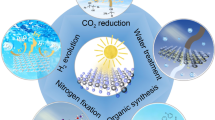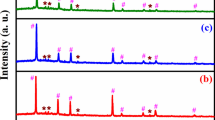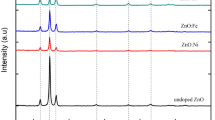Abstract
This work proposes a methodology based on porous silicon (PSi) thermal oxidation in an air atmosphere to reduce its optical losses and change the optical response of one-dimensional photonic structures through the porosity variations, pore filling, and refractive index tuning. First, electrochemical etching was used to fabricate PSi samples at two different anodizing currents and in-situ photoacoustic monitoring was used to guarantee the porous film’s reproducibility. Then, the PSi samples were oxidized in an air atmosphere at temperatures of 600, 800, and 1000 \(^{\circ }\)C and different sintering times (0 h, 5 h, 10 h, and 20 h). All the samples were characterized by Fourier-transform infrared spectroscopy (FTIR) and scanning electronic microscopy (SEM) to determine the chemical and morphological evolution produced for thermal treatment. In addition, the optical properties were analyzed by UV-Vis spectroscopy before and after the thermal treatment to relate the obtained spectra with the characteristics of the monolayers using the transfer matrix method (TMM), effective medium theory, and genetic algorithms (GA). Finally, we predicted the optical response of oxidized porous silicon one-dimensional photonic crystal for UV-Vis range applications.









Similar content being viewed by others
References
Ramirez-Gutierrez CF, Castaño-Yepes JD, Rodriguez-Garcia ME (2018) Optical interferometry and photoacoustics as in-situ techniques to characterize the porous silicon formation: a review. Open Mater Sci 4(1):23–32. https://doi.org/10.1515/oms-2018-0003
Pavesi L (2021) Thirty years in silicon photonics: a personal view. Front Phys. https://doi.org/10.3389/fphy.2021.786028
Lehmann V, Gösele U (1991) Porous silicon formation: a quantum wire effect. Appl Phys Let 58(8):856–858. https://doi.org/10.1063/1.104512
Ramirez-Gutierrez CF, Martinez-Hernandez HD, Lujan-Cabrera IA, Rodriguez-García ME (2019) Design, fabrication, and optical characterization of one-dimensional photonic crystals based on porous silicon assisted by in-situ photoacoustics. Sci Rep 9:14732. https://doi.org/10.1038/s41598-019-51200-1
Lujan-Cabrera IA, Ramirez-Gutierrez CF, Castaño-Yepes JD, Rodriguez-Garcia ME (2019) Effects of the interface roughness in the optical response of one-dimensional photonic crystals of porous silicon. Phys B: Condens Matter 560:133–139. https://doi.org/10.1016/j.physb.2019.02.010
Jiao Y, Weiss SM (2010) Design parameters and sensitivity analysis of polymer-cladded porous silicon waveguides for small molecule detection. Biosens Bioelectr 25(6):1535–1538. https://doi.org/10.1016/j.bios.2009.10.040
Amri C, Ouertani R, Hamdi A, Chtourou R, Ezzaouia H (2016) Effect of porous layer engineered with acid vapor etching on optical properties of solid silicon nanowire arrays. Mater Des 111:394–404. https://doi.org/10.1016/j.matdes.2016.08.082
Korotcenkov G, Cho BK (2010) Silicon porosification: state of the art. Critical Rev Solid State Mater Sci 35(3):153–260. https://doi.org/10.1080/10408436.2010.495446
Kopani M, Mikula M, Kosnac D, Vojtek P, Gregus J, Vavrinsky E, Jergel M, Pincik E (2018) Effect of etching time on structure of p-type porous silicon. Appl Surface Sci 461:44–47. https://doi.org/10.1016/j.apsusc.2018.04.228
Ramirez-Gutierrez CF, Medina-Herrera A, Tirado-Mejía L, Zubieta-Otero LF, Auciello O, Rodriguez-Garcia ME (2018) Photoluminescence study of porous p-type silicon: identification of radiative transitions. J Lumin 201:11–17. https://doi.org/10.1016/j.jlumin.2018.04.036
Isaiev M, Newby PJ, Canut B, Tytarenko A, Lishchuk P, Andrusenko D, Gomès S, Bluet J-M, Fréchette LG, Lysenko V, Burbelo R (2014) Thermal conductivity of partially amorphous porous silicon by photoacoustic technique. Mater Let 128:71–74. https://doi.org/10.1016/j.matlet.2014.04.105
Ramirez-Gutierrez CF, Lujan-Cabrera IA, Isaza C, Anaya-Rivera EK, Rodriguez-Garcia ME (2021) In situ photoacoustic study of optical properties of p-type (111) porous silicon thin films. Nanomaterials. https://doi.org/10.3390/nano11051314
Pirasteh P, Charrier J, Soltani A, Haesaert S, Haji L, Godon C, Errien N (2006) The effect of oxidation on physical properties of porous silicon layers for optical applications. Appl Surface Sci 253(4):1999–2002. https://doi.org/10.1016/j.apsusc.2006.03.083
Lin C-H (2008) In: Li D (ed) Oxidation (of Silicon). Springer, Boston, MA, pp 1584–1584. 10.1007/978-0-387-48998-8_1173
Massoud HZ, Plummer JD, Irene EA (1985) Thermal oxidation of silicon in dry oxygen: accurate determination of the kinetic rate constants. J Electrochem Soc 132(7):1745–1753. https://doi.org/10.1149/1.2114204
Massoud HZ, Plummer JD, Irene EA (1985) Thermal oxidation of silicon in dry oxygen growth-rate enhancement in the thin regime: i. experimental results. J Electrochem Soc 132(11):2685–2693. https://doi.org/10.1149/1.2113648
Massoud HZ, Plummer JD, Irene EA (1985) Thermal oxidation of silicon in dry oxygen: Growth-rate enhancement in the thin regime: i. physical mechanisms. J Electrochem Soc 132(11):2693–2700. https://doi.org/10.1149/1.2113649
Cisneros R, Pfeiffer H, Wang C (2010) Oxygen absorption in free-standing porous silicon: a structural, optical and kinetic analysis. Nanoscale Res Let 5(4):686. https://doi.org/10.1007/s11671-010-9532-2
Ghafarinazari A, Zera E, Lion A, Scarpa M, Sorarù GD, Mariotto G, Daldosso N (2016) Isoconversional kinetics of thermal oxidation of mesoporous silicon. Thermochimica Acta 623:65–71. https://doi.org/10.1016/j.tca.2015.11.017
Pap AE, Kordás K, George TF, Leppävuori S (2004) Thermal oxidation of porous silicon: study on reaction kinetics. J Phys Chem B 108(34):12744–12747. https://doi.org/10.1021/jp049323y
Pap AE, Kordás K, Tóth G, Levoska J, Uusimäki A, Vähäkangas J, Leppävuori S, George TF (2005) Thermal oxidation of porous silicon: study on structure. Appl Phys Let 86(4):041501. https://doi.org/10.1063/1.1853519
Bardet B, De Sousa Meneses D, Defforge T, Billoué J, Gautier G (2016) In situ investigation of mesoporous silicon oxidation kinetics using infrared emittance spectroscopy. Phys Chem Chem Phys 18:18201–18208. https://doi.org/10.1039/C6CP02086K
Isaiev M, Mussabek G, Lishchuk P, Dubyk K, Zhylkybayeva N, Yar-Mukhamedova G, Lacroix D, Lysenko V (2022) Application of the photoacoustic approach in the characterization of nanostructured materials. Nanomaterials. https://doi.org/10.3390/nano12040708
Ramirez-Gutierrez CF, Castaño-Yepes JD, Rodriguez-García ME (2017) Modeling the photoacoustic signal during the porous silicon formation. J Appl Phys 121:025103. https://doi.org/10.1063/1.4973940
Ramirez-Gutierrez CF, Castaño-Yepes JD, Rodriguez-Garcia ME (2016) In situ photoacoustic characterization for porous silicon growing: detection principles. J Appl Phys 119:185103. https://doi.org/10.1063/1.4948946
ParticleSizer. https://imagej.net/ParticleSizer
Torres-Acosta V, Martín-Palma RJ, Martínez-Duart JM (2004) Optical constants of porous silicon films and multilayers determined by genetic algorithms. J Appl Phys 96:4197. https://doi.org/10.1063/1.1786672
Ramirez-Gutierrez CF, CastaÑo-Yepes JD, Rodriguez-Garcia ME (2018) Porosity and roughness determination of porous silicon thin films by genetic algorithms. Optik 173:271–278. https://doi.org/10.1016/j.ijleo.2018.08.019
Missoni LL, Ortiz GP, Martínez Ricci ML, Toranzos VJ, Mochán WL (2020) Rough 1d photonic crystals: a transfer matrix approach. Opt Mater 109:110012. https://doi.org/10.1016/j.optmat.2020.110012
Estrada-Wiese D, Río JAd (2018) Refractive index evaluation of porous silicon using bragg reflectors. Revista mexicana de física 64:72–81
Choy TC (2015) Effective medium theory: principles and applications, 2nd edn. International series of monographs on physics. Oxford University Press, Oxford, p 240
Liu X-D, Hou Z-L, Zhang B-X, Zhan K-T, He P, Zhang K-L, Song W-L (2016) A general model of dielectric constant for porous materials. Appl Phys Lett 108(10):102902. https://doi.org/10.1063/1.4943639
Peng Y, Zhou J, Zheng X, Zhao B, Tan X (2011) Structure and photoluminescence properties of silicon oxycarbide thin films deposited by the rf reactive sputtering. Int J Modern Phys B 25(22):2983–2990. https://doi.org/10.1142/S0217979211100412
Lenshin A, Kashkarov V, Tsipenyuk V, Seredin P, Agapov B, Minakov D, Domashevskaya E (2013) Optical properties of porous silicon processed in tetraethyl orthosilicate. Tech Phys. https://doi.org/10.1134/S1063784213020151
Krivoshein PK, Volkov DS, Rogova OB, Proskurnina MA (2020) Ftir photoacoustic spectroscopy for identification and assessment of soil components: chernozems and their size fractions. Photoacoustics 18:100162. https://doi.org/10.1016/j.pacs.2020.100162
Han L, Mandlik P, Gartside J, Wagner S, Silvernail JA, Ma R-Q, Hack M, Brown JJ (2009) Properties of a permeation barrier material deposited from hexamethyl disiloxane and oxygen. J Electrochem Soc 156(2):106. https://doi.org/10.1149/1.3028308
Arad-Vosk N, Sa’ar A (2014) Radiative and nonradiative relaxation phenomena in hydrogen- and oxygen-terminated porous silicon. Nanoscale res let 9:47. https://doi.org/10.1186/1556-276X-9-47
Lenshin AS, Seredin PV, Agapov BL, Minakov DA, Kashkarov VM (2015) Preparation and degradation of the optical properties of nano-, meso-, and macroporous silicon. Mater Sci Semicond Processing 30:25–30. https://doi.org/10.1016/j.mssp.2014.09.040
Mawhinney DB, Glass JA, Yates JT (1997) Ftir study of the oxidation of porous silicon. J Phys Chem B 101(7):1202–1206. https://doi.org/10.1021/jp963322r
Young TF, Chen CP, Liou JF, Yang YL, Chang TC (2000) Study on the si-si vibrational states of the near surface region of porous silicon. J Porous Mater 7(1):339–343. https://doi.org/10.1023/A:1009622601723
Launer PJ, Arkles B (2013) Infrared analysis of organosilicon compounds: spectra-structure relationships. In: Arkles B, Larson G (eds) Silicon compounds: silanes and silicones (pp. 175–178). Gelest Inc. https://doi.org/10.5281/zenodo.3696063
Falcão BP, Leitão JP, Soares MR, Ricardo L, Águas H, Martins R, Pereira RN (2019) Oxidation and strain in free-standing silicon nanocrystals. Phys Rev Appl 11:024054. https://doi.org/10.1103/PhysRevApplied.11.024054
Martin-Sanchez D, Ponce-Alcantara S, Martinez-Perez P, Garcia-Ruperez J (2019) Macropore formation and pore morphology characterization of heavily doped p-type porous silicon. J Electrochem Soc 166:9–12. https://doi.org/10.1149/2.0051902jes
Escobar-Carrasquilla JD, Álvarez-Macías C, Dutt A, Mon-Pérez E, Huerta L, Santana G (2017) Influence of oxygen concentration on the optoelectronic properties of hydrogenated polymorphous silicon thin films. Thin Solid Films 638:389–395. https://doi.org/10.1016/j.tsf.2017.08.004
Ogata YH, Yoshimi N, Yasuda R, Tsuboi T, Sakka T, Otsuki A (2001) Structural change in p-type porous silicon by thermal annealing. J Appl Phys 90(12):6487–6492. https://doi.org/10.1063/1.1416862
Kuzma-Filipek I (2014). In: Canham L (ed) Sintering of porous silicon. Springer, Cham, pp 599–610. https://doi.org/10.1007/978-3-319-05744-6_62
Marcos LVR-d, Larruquert JI, Méndez JA, Aznárez JA (2016) Self-consistent optical constants of SiO\(_2\) and Ta\(_2\)O\(_5\) films. Opt Mater Express 6(11):3622–3637. https://doi.org/10.1364/OME.6.003622
Khashan MA, Nassif AY (2001) Dispersion of the optical constants of quartz and polymethyl methacrylate glasses in a wide spectral range: 0.2–3 \(\mu\)m. Opt Commun 188(1):129–139. https://doi.org/10.1016/S0030-4018(00)01152-4
Green MA (2008) Self-consistent optical parameters of intrinsic silicon at 300k including temperature coefficients. Sol Energy Mater Sol Cells 92(11):1305–1310. https://doi.org/10.1016/j.solmat.2008.06.009
Acknowledgements
The authors thank Beatriz Millan-Malo for XRD measurements and analysis. This work was supported by CONACYT-México through PNPC and SNI scholarships programs, PAEP-UNAM program, and UNAM-Laboratorio Nacional de Caracterización de Materiales (LaNCaM). Thanks to Laboratorio de Sistemas Tecnológicos Aplicados (STA) from UPQ from data simulations and visualizations.
Author information
Authors and Affiliations
Corresponding author
Ethics declarations
Conflict of interest
There are no conflict of interest.
Additional information
Handling Editor: Kevin Jones.
Publisher's Note
Springer Nature remains neutral with regard to jurisdictional claims in published maps and institutional affiliations.
Appendices
Appendix
In-situ x-ray diffraction
The sample was packed in a platinum holder located in a controlled high-temperature device, Ultima IV-Rigaku diffractometer. The sample was analyzed through in-situ HT-XRD measurement at 2 \(^{\circ }\)C/min with \(\hbox {CuK}_{\alpha }\) radiation \(\lambda =1.5406\) Å. XRD patterns were obtained every 50 \(^{\circ }\)C from room temperature (22 \(^{\circ }\)C) to 1000 \(^{\circ }\)C during heating. Diffractograms were obtained from 10\(^{\circ }\) to 80\(^{\circ }\) on a 2\(\theta\) scale with a step size of 0.02\(^{\circ }\). Finally, the sample was inertially cooled to room temperature, and a diffraction pattern was taken (25\(^{\circ }\)).
A peak of about 69.17\(^{\circ }\) (in 2\(\theta\)) corresponds to the (400) plane of the silicon substrate, which shifts at smaller angles as temperature increases due to thermal expansion. A peak of about 20.85\(^{\circ }\) was observed that corresponds to the (100) plane of quartz. The peak increases in intensity as the temperature increases, which is indicative of an oxide layer growing. Finally, for the sample measured at room temperature once the thermal treatment finishes, the silicon peak reduces in intensity, and the quartz peak looks more intense, which is an indicator of silicon consumption to create silicon oxide.
Raw films Uv-Vis
Oxidized films UV-Vis
Figure 13
Rights and permissions
About this article
Cite this article
Sierra-Moreno, R.F., Lujan-Cabrera, I.A., Cabrera-Teran, J.M. et al. Study of the optical response of oxidized porous silicon structures by thermal oxidation in air. J Mater Sci 57, 11226–11241 (2022). https://doi.org/10.1007/s10853-022-07376-5
Received:
Accepted:
Published:
Issue Date:
DOI: https://doi.org/10.1007/s10853-022-07376-5








